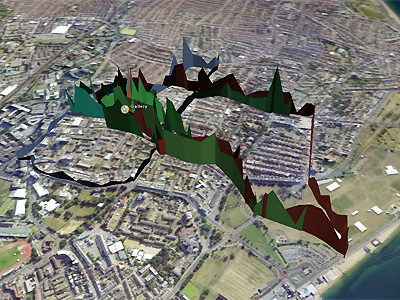 Is there a number of crucial or core works in locative media? A corpus of best practices? At the International Symposium on Electronic Art it seemed that there might be; many presentations referred to the same set of examples. Some other presentations came up with ways of classifying locative media in different categories. Here is an overview.
Is there a number of crucial or core works in locative media? A corpus of best practices? At the International Symposium on Electronic Art it seemed that there might be; many presentations referred to the same set of examples. Some other presentations came up with ways of classifying locative media in different categories. Here is an overview.
- Biomapping by Christian Nold was probably the work that most often appeared at ISEA. It was often presented as an example of what could be called ‘communal experience mapping’.
- The works of Esther Polak (Amsterdam Realtime) and Milk also came up quite often. Both works were framed as examples of using ‘tracking’ technology in an artistic context.
- Proboscis Urban Tapestries was cited more than once as example of a community driven geo-annotation project
- The works of Blast Theory (Uncle Roy all around us, Can you see me now, Day of the Figurines) were often given as examples of hybrid gaming.
- The fifth locative classic is not a single work, but rather a category: that of (psychogeographic) walks. Quite a few examples were given such as Shadowed Spaces, .Walk, Joyce Walks and Peninsular voices
 |
 |
Marc Tuters on Milk:
MILK suggests a powerful vision of how locative technologies could allow one to more fully understand how products are commodi?ed and distributed through the actions of global trade, thereby making visible the networked society.
 |
Tapio Mäkelä:In Urban and Social Tapestries by Proboscis, location based media becomes a tool and a platform for experimental ethnography. Much in the tradition of community arts, collective narration of places becomes a way of not only writing or making media about them but for creating a new kind of sociability between the
participants as co-authors and co-readers.
 |
Daniel Palmer: [the works of blast theory] move beyond mobile entertainment to draw attention to the antagonistic, performative, interdependent and
embodied basis of our social relations.
Tapio Mäkelä: In Blast Theory projects Uncle Roy All Around You (2003) and Can You See Me Now? (2002), places are part of a game scenario. Usage of street and remote players creates a tension between performing in place, and being able to remotely take part. Even though GPS coordinates
are relevant from a functional design perspective and perhaps contribute to a location based imaginary, in these works affects of the social and playability are more central than affect of place. Rather than talking about a more permanent sense of a place, following Pierre Mayol’s concepts of the neighborhood, in these Blast Theory projects a pedestrian temporal experience becomes momentarily sharable. Participation is the key, without which these works are not accessible.
Classifications
I came across three different ways of classifying locative media that I found useful for conceptualizing locative media.
-
Marc Tuters
Tuters briefly refered to his useful, earlier made categorization based on functionality:
*annotative—virtually tagging the world
*phenomenological—tracing the action of the subject in the world - Chris Bowman and Teresa Leung
They used Drew Hemments classification of Locative Media, that consists of three types:
*mapping
*geo-annotation
*walks - Brian Degger
came up with a 5-way classification of locative works
* Locative-narrative — a story that traverses the city;
* Community storytelling / authorship — locative technology used to tag space;
*Psych tours — psychogeographical tours of the space to enable a new mapping
of a hybrid space across time or literature;
* World Growing — facilities created that refer to another location;
* Playing the city — using as an instrument


One response to “ISEA 2008: Locative Media Core Works & Classifications”
[…] ISEA 2008: Locative Media Core Works & Classifications (Conference Report) […]